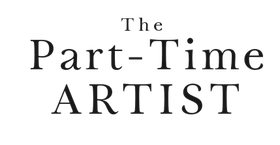As many of you already know, I have recently started my own podcast, with 2 episodes currently available. Being a podcast host is something I’ve dreamed of for several years. I used to be a radio presenter and programmer when I was at university, and lately I’ve been aching to go back to these roots.
So far, it’s going very well, and I’m having a great time. And it occured to me that some of you might be tempted to do the same!
I know from experience that when you start researching “how to start a podcast”, you get thousands of links and most of them are not very helpful. There’s often too much information, and they usually imply that you have to spend a lot more than you can afford at the beginning.
So today, I’ve decided to write an article that will show you everything I did to start my podcast, and the EXACT amount of money I’ve paid. The equipment and softwares I use are not necessarily the most professional, but they allow me to get a decent quality for a newbie.
Equipment
To start a podcast, you will need a microphone. Preferably, not your computer’s microphone. Professionals use XLR microphones, but I couldn’t afford them. So instead, I chose to go with USB microphones. I researched Amazon for several days, read a lot of blog posts about different models, and finally settled on one:

It’s the Alvoxcon Unidirectional Condenser USB microphone for computers.
I LOVE this microphone. I love it so much, actually, that I bought two: one for me, and one for guests. The quality is great for the price, it’s directional enough that it doesn’t pick up too much noise, and it makes it simple to clean the background in post-production. It’s super easy to set up, and to transport. It comes with a bonnette that covers some parasite sounds and a small tripod. Using it is easy, it’s just plug and play!
Budget: I paid £26.99 per microphone (although like everything on Amazon, the price varies), so £53.98 (around $69). By far, my biggest expense, but still much less than what an XLR microphone would have cost me.
Upgrade: I’m considering buying a filter to place in front of the microphone to reduce “mouth noises” like clicking sounds. In the future, I’ll upgrade to a proper XLR microphone and mixer system, but only if I can pay for it with sponsors / Patreon supports.
Studio
I record all episodes in my bedroom. I don’t have a proper studio but it’s the quietest room in my small flat. Some of you might want to try the bathroom, as the acoustics might be better there.
Considering that I’m not in a professional radio studio, I’ve decided to build a “diffusion panel” to avoid problems like echoing. I couldn’t really glue foam to the walls because I’m renting (and also it’s ugly!) so I built a temporary panel out of carton, foam and glue. Here’s how I did it:
Material:
- A set of acoustic foam tiles, such as these ones:

- Scissors to cut the tiles to the right dimensions.
- Glue spray, such as this one:

- Carton box
- Duct tape
I opened the box flat and glued the foam panels on it, being careful to leave room for folding the panel. As you can see, I measured the tiles and cut some of them to fit the area of the carton that I needed to be covered. The bottom is not covered, as it will be the base of the panel.
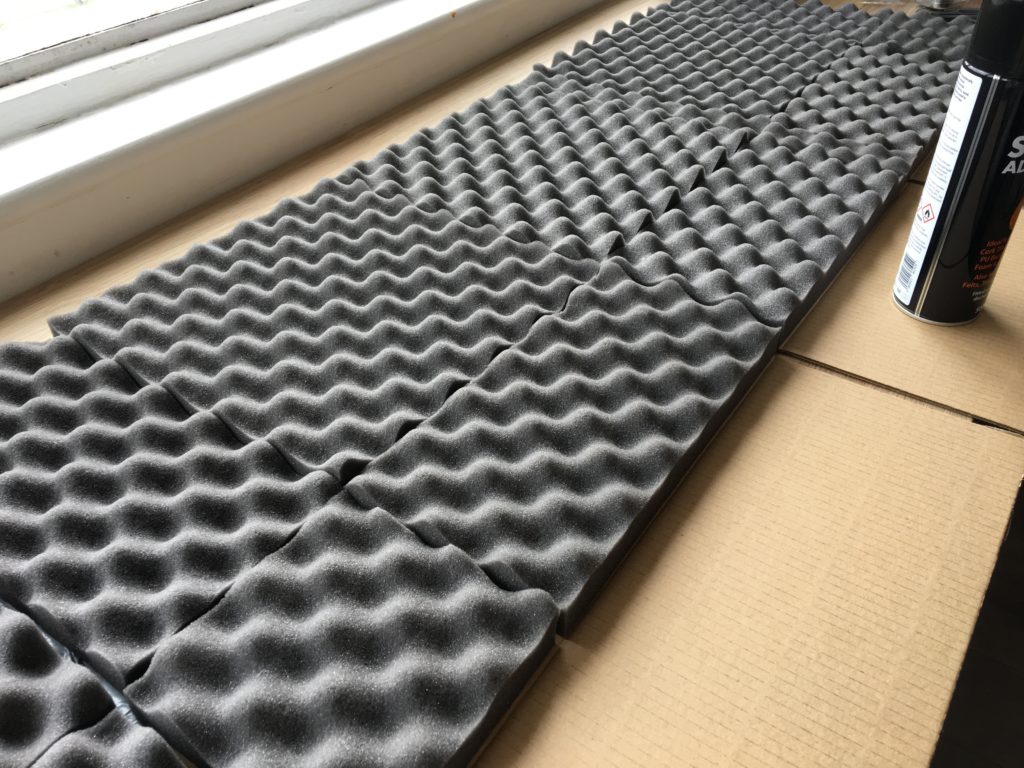
Once dry, the panel is attached in position with duct tape.
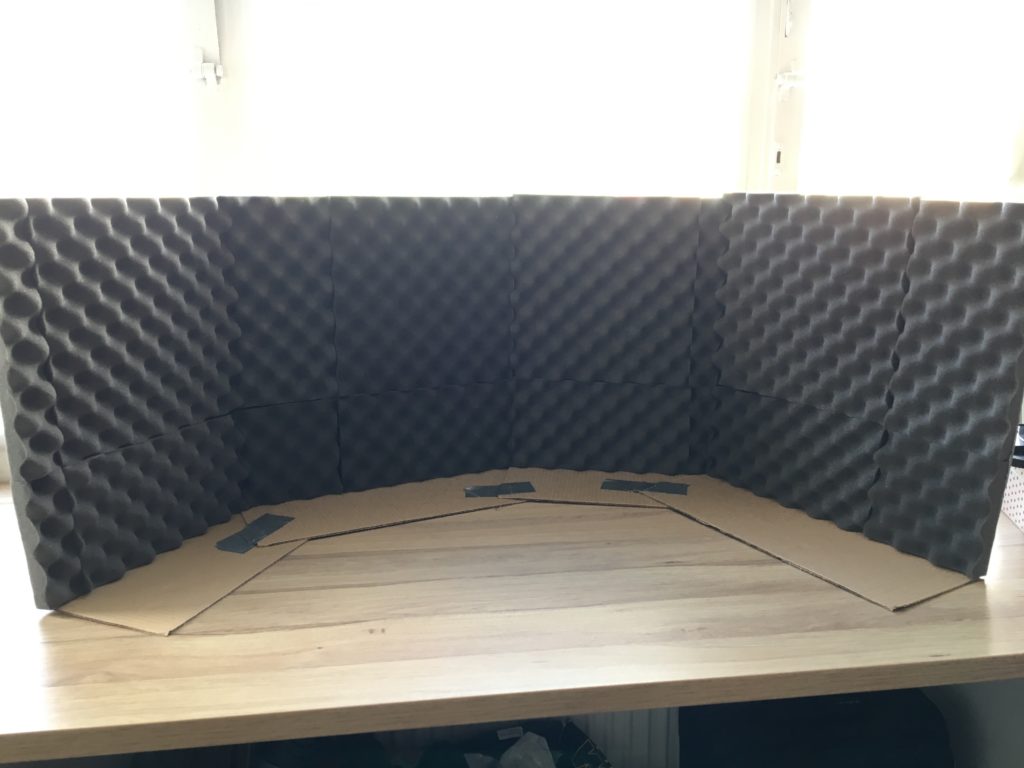
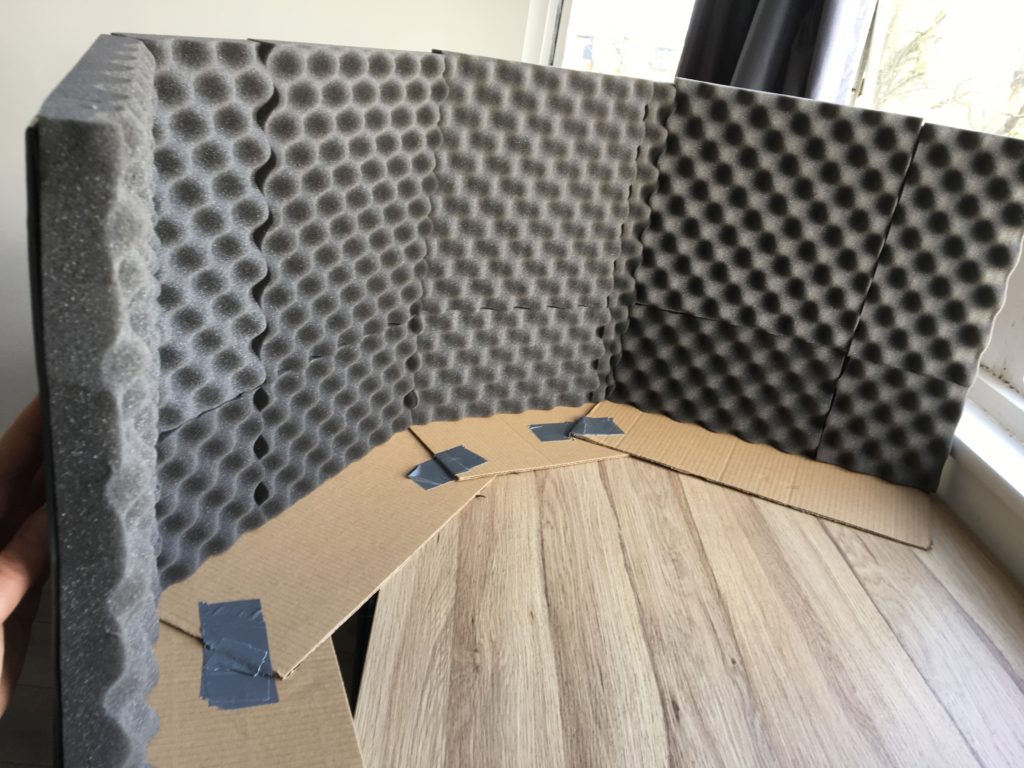
And when I don’t use it, the panel is foldable and doesn’t take too much space.
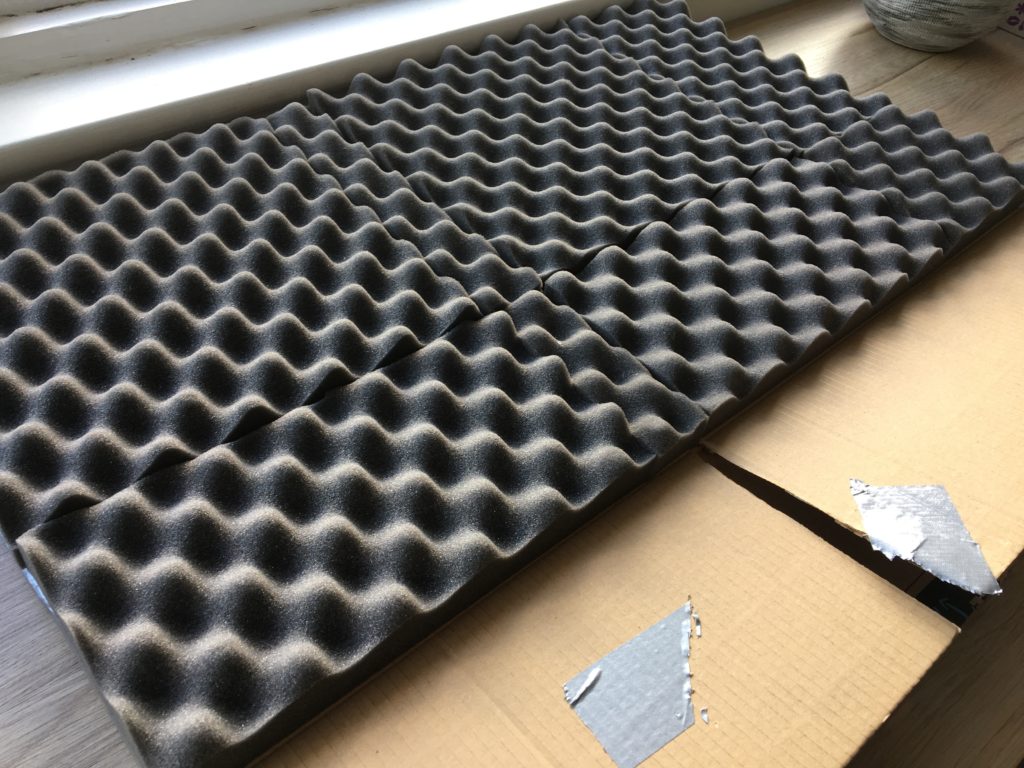
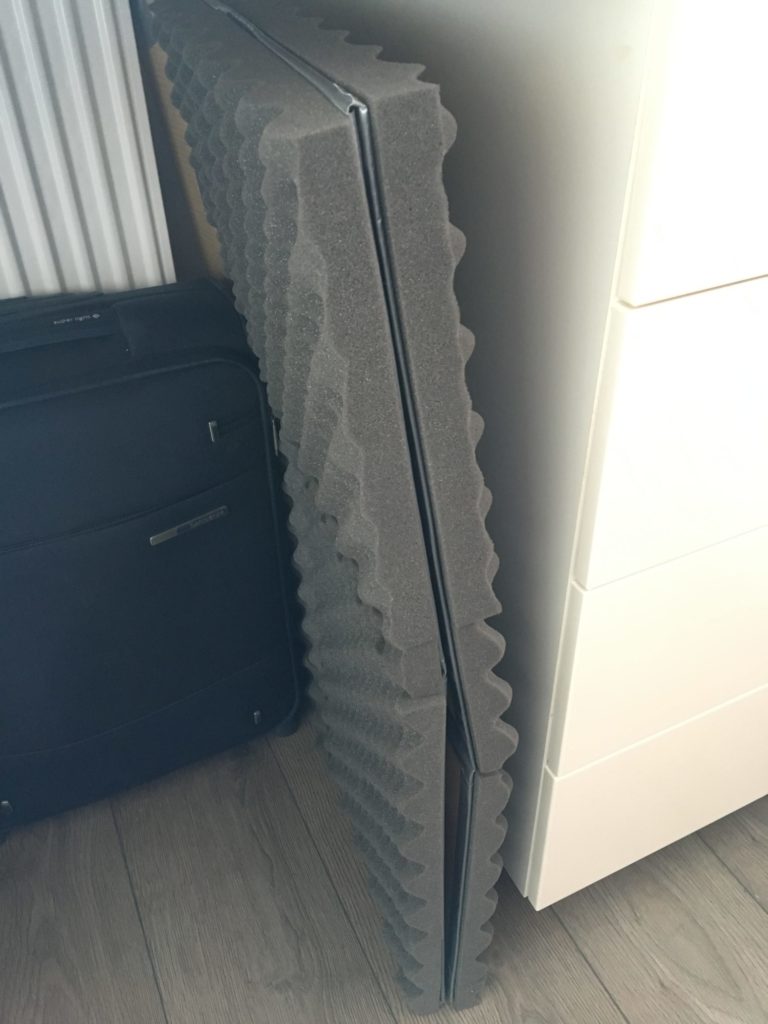
Budget: The foam costed me £16.99 for 10 tiles. The glue was £4.95. I already had duct tape, and used the box that the foam came it (Amazon is practical that way!). Total cost: £21.94 (around $28).
Upgrade: Not sure yet. The best solution would be to have a house where a full room is dedicated to recording, but it’s not possible right now. Perhaps more panels?
Music
The intro, outro and transitions of the podcast all use the same music. I use a website called TeknoAXE, and the song is Shuffle Through the Night.
All songs on this website are licensed under a Creative Commons Attribution 4.0 International License, which means that I can use them for free for the podcast. Don’t make the mistake to use copyrighted music for your podcast, or you might get in trouble!
I highly encourage you to search “royalty free” music on Google if you are looking for a music for your podcast.
Budget: £0!
Upgrade: I would love to collaborate with a musician to make an original music for the podcast. Perhaps for season 2?
Software
I mainly use three softwares to do the podcast:
- Audacity: it’s an open source sound editing software, and it’s FREE! I am honestly amazed at the fact that this software is still free, because it’s so powerful! I record directly on it, I clean the noise, and I edit the episodes together, all that in one software. Of course, it’s not as advanced as something like Adobe Audition, but it’s still awesome! If you start a podcast, this is THE software you need.
- Skype: oh, the good old Skype! It’s the simplest and most widely used tool to communicate with guests who don’t live near you. Of course, it’s far from perfect and can cause issues, but most of the time your guests will already have it and it will avoid them having to install something new. And it’s free too!
- Piezo: I use this software to record my Skype conversations. It’s easy to use and so far I’ve found it reliable. Piezo is not free but you can try it for 10 minutes and decide if the quality is good enough for you. It’s only available on Mac, but I’m pretty sure there are excellent alternatives for PC too. (Note: you can already record conversations in Skype, but the audio is mixed together, which means that the quality is pretty poor. In my opinion, you need something better!)
Budget: the licence for Piezo costs £18.20 ($22.80).
Upgrade: I would love to use Adobe Audition, but the fact that you have to pay every month (as opposed to just buy the software) is a big deterrent for me. I’m thinking about replacing Skype with Zoom at some point, so I can also record the video.
Design
To start a podcast, you will need at least one artwork. You have probably seen mine several times:
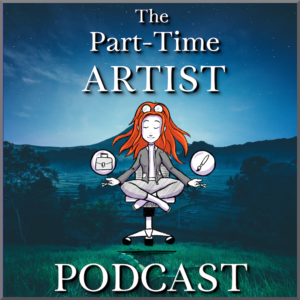
I used one of the illustrations that was originally made for my book, by Juan Carlos Porcel. The background is an image that I found on a website called Pexels, where a lot of artists post free stock photos. The font is called Tryst, and it’s free for commercial use.
To edit all this together, I use the free image manipulation program Gimp. This software is THE one you need to use if you can’t afford Photoshop. It’s a little complicated to understand at first, but now I use it all the time for many different projects.
Budget: £0!
Upgrade: I really love this artwork, so I don’t plan on upgrading it any time soon.
Hosting
This is something that I was not aware when I started my podcast: you can’t host the episodes on your own website. You need a hosting that has enough bandwidth to allow several people to listen to the episodes at the same time.
After researching several solutions, I’ve decided to use Buzzsprout, and I chose at first the free plan. The free plan is however limited and adds adverts to your episodes, so I immediately upgraded to their cheapest plan ($12 per month, around £9). With that plan, I can upload up to 3 hours of content per month, and the podcast is hosted indefinitely.
Buzzsprout has a feature that allows you to upload your podcast on Apple Podcast, Spotify, Google (if you are in the US or Canada), Stitcher and Alexa. I have also used their support service because I had a minor problem with the first episode, and they responded within an hour. In addition to hosting your podcast, they also offer solutions to share it, such as players that can be embed on your blog, and a dedicated website for your podcast.
So far, I’m SUPER happy with this hosting, and I’m looking forward to unlocking some features like statistics and audience (you need to have 3 episodes uploaded before analytics can be produced).
Thinking about using Buzzsprout too? I have GREAT NEWS for you! If you subscribe to one of their paid plans for 2 months by clicking on this personal referral link, we will both get a $20 Amazon.com gift card!
Budget: £9 per month ($12).
Upgrade: Right now, I don’t feel like I need to upgrade to a better plan yet. If the podcast becomes a weekly one, I might need more storage.
TOTAL BUDGET
In total, I paid £103.12 ($133) to get this podcast running for the first month (April 2019). You can reduce it to £58 ($75) if you don’t have any guest. I think it’s not bad at all!
The hosting is going to be an ongoing cost, so I created a Patreon sponsoring page to pay for it.
In Conclusion
You don’t need a lot of money to create a podcast. Don’t let a small budget stop you. Making a podcast is fun, and in my opinion it’s more interesting to learn while doing it than just wait.
Are you an aspiring podcaster? Do you have more questions about how I got my podcast running? Or do you have a new podcast that you’d like me to discover? Head to the comments below!
Céline is an author passionate about helping fellow artists reach their potential and live a happy, balanced life.
